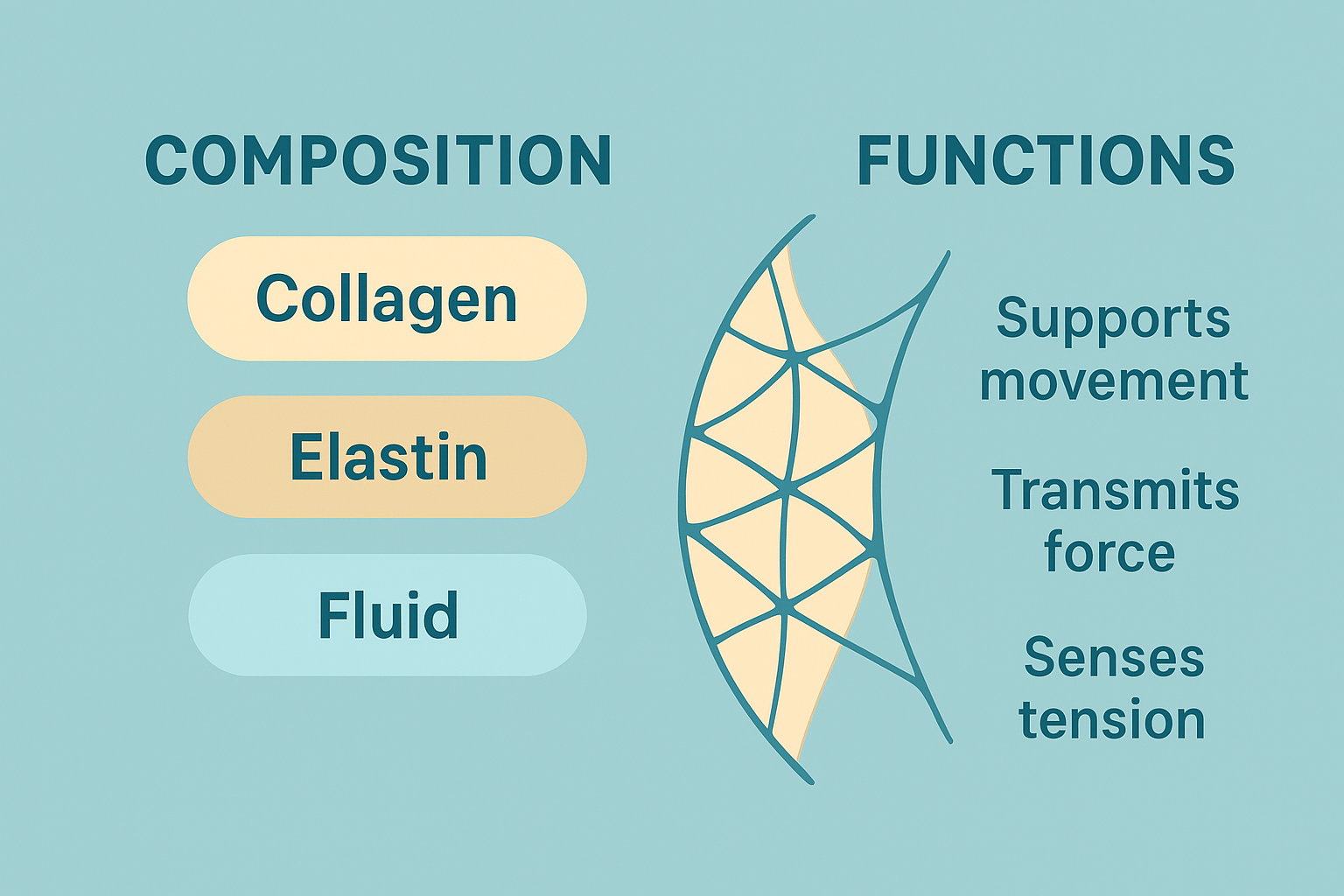Scoliosis changes the spine’s shape and how the body balances. But the connective web that surrounds and links tissues, the fascia, also influences back pain, stiffness and movement in many different ways.
Brief overview
This article adapts Jean François Brabant’s explanation of fascia and uses it to look at how the tissue matters for people with scoliosis. Fascia is described here as a continuous, living network that supports muscles, organs, nerves and the spaces between them.
We explain how fascia moves force and fluid, and how its sensory role can affect posture and comfort when the spine has a curve.
What you’ll find in this article:
- Simple-to-understand explanations of what fascia does and why it matters for scoliosis.
- Common reasons fascia contributed to reduced mobility and how that can cause wider discomfort.
- General ways to support tissue health alongside your existing scoliosis care, and how to discuss these options with an experienced physiotherapist.
What is fascia? A brief explanation
Fascia is a living web of tissue made of strong, flexible fibers held in a water-rich gel. It wraps around and links muscles, bones, nerves and organs throughout the body.
In simple terms, fascia:
- holds the body’s shape and provides support
- passes force from one area to another to help movement
- lets fluid move between layers so tissues can glide smoothly
- cushions shocks and sends sensory signals that help with posture and motion

Fascial cells slowly adjust the fibers and gel when we move, rest, or get injured. Because these changes happen over time, small daily habits tend to matter most.
Regular gentle movement, steady hydration, and good sleep help fascia stay supple. Rather than quick fixes, gradual, consistent care usually gives the most lasting benefit.
Why fascia can become tight, painful or less mobile
Everyday unfavorable habits and events can make fascia feel tight or less able to move.
Common causes include:
- repeating the same movements or favouring one side
- sitting for long periods or being still for too long
- injury or overuse
- ongoing stress that keeps muscles tense
- not drinking enough water or poor sleep
- natural changes with age or metabolism
When a part of the body is overloaded, the body can make the tissue denser as a short-term protection. That thicker tissue doesn’t glide as well, so movement becomes harder.
Sometimes layers of fascia can start to stick together. These are called adhesions, and that makes motion even more limited. Inflammation and poor circulation can add to the problem, and stress can keep muscles and fascia tight.
Fascia and back pain with scoliosis
Because fascia forms a continuous network, small areas of tightness can create widespread back pain. This helps explain why scans may look normal even when discomfort persists.
Common sensations include:
- A general ache across parts of the back
- Stiffness that improves with gentle movement
- Tender or sensitive spots that come and go
Understanding how fascia contributes to pain can shift the focus from looking for structural damage to observing how tissues behave and how sensitive the nervous system becomes.
Helpful general ways to manage this kind of discomfort include:
- Pacing activity rather than overdoing movement
- Adding gentle variety to daily movement
- Using light, supportive care to reduce sensitivity and restore ease
This steady, mindful approach is often more effective than rushing into invasive treatments, especially when the pain isn’t caused by a serious medical issue.

Helpful, safe methods to support fascial health
Supporting fascia often comes down to simple, steady habits that improve circulation, and tissue comfort over time.
- Gentle, regular movement
- Take short walks or do easy range-of-motion exercises.
- Break up long sitting periods
- Stand, stretch, or move briefly to prevent stiffness and reduce strain.
- Stay hydrated and get good sleep
- Drink water regularly throughout the day.
- Prioritize restorative sleep to keep fascia’s water-rich structure healthy and flexible.
- Manage stress
- Try simple calming practices like slow breathing, short guided relaxation, or mindful pauses during the day.
- Skilled hands-on care
- Some people benefit from gentle, sustained manual techniques when done by an experienced physiotherapist.
- These work best when paired with everyday habits like movement and hydration.
- If you’re curious, start with booking an appointment with our physiotherapists and notice how your body responds before continuing.
- General tips for progress
- Begin with small, consistent steps and track how your comfort changes.
- Gradually add variety to your movements instead of doing too much at once.
- Always coordinate new fascial work with your physiotherapist so it fits smoothly with your existing scoliosis plan, including bracing or exercise routines.
- Gentle, regular movement
How fascia work fits with scoliosis care
Fascia-focused approaches are meant to support, not replace, traditional scoliosis care. Core treatments such as:
- Bracing
- Therapeutic exercise
- Structured movement programs
These remain essential for managing curve progression and muscular support.
A collaborative approach works best:
- Talk with our experienced physiotherapists about whether gentle fascial strategies might fit your plan.
- Coordinate timing and intensity so new techniques don’t interfere with ongoing treatments.
- Keep communication open. This helps ensure all parts of care work together smoothly.
When to Seek Assessment
Knowing when to get checked helps keep care safe and effective.
It is recommended to seek an assessment when you notice:
- Sudden or severe pain
- New numbness, tingling, or weakness
- Changes in bladder or bowel control
For ongoing discomfort, it’s worth:
- Booking an assessment with our experienced physiotherapists
- Exploring whether fascial tension might be contributing to stiffness or discomfort
- Using the session as a chance to discuss gentle next steps that fit your needs
If you’d like, you can also book an appointment with us to talk through your symptoms and options.

Takeaways
Fascia is a living, continuous network that affects:
- How we move
- How we feel pain or sensitivity
- How the body adapts to spinal curves
To support healthy fascia, simple everyday habits can help:
- Gentle movement to keep tissues flexible
- Good hydration and restful sleep to maintain fluid balance
- Stress management to ease muscle and tissue tension
- Skilled hands-on care, when appropriate, for extra support
Small, steady steps practiced over weeks and months often lead to real improvements in comfort and mobility, especially for people living with scoliosis.

